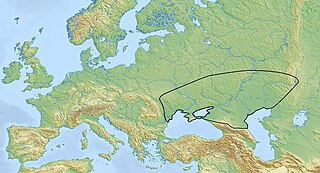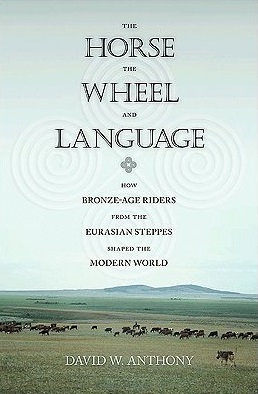Related Research Articles

A kurgan is a type of tumulus constructed over a grave, often characterized by containing a single human body along with grave vessels, weapons, and horses. Originally in use on the Pontic–Caspian steppe, kurgans spread into much of Central Asia and Eastern, Southeast, Western, and Northern Europe during the third millennium BC.
The 35th century BC in the Near East sees the gradual transition from the Chalcolithic to the Early Bronze Age. Proto-writing enters transitional stage, developing towards writing proper. Wheeled vehicles are now known beyond Mesopotamia, having spread north of the Caucasus and to Europe.

The Yamnaya culture or the Yamna culture, also known as the Pit Grave culture or Ochre Grave culture, is a late Copper Age to early Bronze Age archaeological culture of the region between the Southern Bug, Dniester, and Ural rivers, dating to 3300–2600 BC. It was discovered by Vasily Gorodtsov following his archaeological excavations near the Donets River in 1901–1903. Its name derives from its characteristic burial tradition: Я́мная is a Russian adjective that means 'related to pits ', as these people used to bury their dead in tumuli (kurgans) containing simple pit chambers. Research in recent years has found that Mikhaylovka, in lower Dnieper river, Ukraine, formed the Core Yamnaya culture.

The Maykop culture or Maikop culture, c. 3700 BC–3000 BC, is a major Bronze Age archaeological culture in the western Caucasus region.
The Sarmi-Jayapura Bay languages consist of half a dozen languages spoken on the northern coast of Papua province of Indonesia:
Yamna may refer to:

The Samara culture is an Eneolithic culture dating to the turn of the 5th millennium BCE, at the Samara Bend of the Volga River. The Samara culture is regarded as related to contemporaneous or subsequent prehistoric cultures of the Pontic–Caspian steppe, such as the Khvalynsk, Repin and Yamna cultures.

The Middle Dnieper culture or the Middle Dnipro culture is a formative early expression of the Corded Ware culture, ca. 2800–1800 BC, of northern Ukraine and Belarus.
YMN or ymn may refer to:
Russian archaeology begins in the Russian Empire in the 1850s and becomes Soviet archaeology in the early 20th century. The journal Sovetskaya arkheologiya is published from 1957.

Sarmi Regency is one of the regencies (kabupaten) in Papua Province of Indonesia. It was formed from the western districts which had until then been part of Jayapura Regency with effect from 12 November 2002. It covers an area of 18,034.0 km2, and had a population of 32,971 at the 2010 Census and 41,515 at the 2020 Census; the official estimate as at mid 2023 was 42,680. The regency's administrative centre is at the town of Sarmi.

The 8th European Cross Country Championships were held at Thun in Switzerland on 9 December 2001. Serhiy Lebid took his second title in the men's competition and Yamna Belkacem won the women's race.

The Horse, the Wheel, and Language: How Bronze-Age Riders from the Eurasian Steppes Shaped the Modern World is a 2007 book by the anthropologist David W. Anthony, in which the author describes his "revised Kurgan theory." He explores the origins and spread of the Indo-European languages from the Pontic–Caspian steppe throughout Western Europe, Central Asia, and South Asia. He shows how the domesticated horse and the invention of the wheel mobilized the steppe herding societies in the Eurasian Steppe, and combined with the introduction of bronze technology and new social structures of patron-client relationships gave an advantage to the Indo-European societies. The book won the Society for American Archaeology's 2010 Book Award.

Yamna Carolina Lobos Astorga is a popular Chilean dancer, television host, and actress.
Bang TV was a Chilean television channel owned by TVI Filmocentro S.A focused on music ranging from the broadcasting of national production, also including genres like Reggaetón, K-pop and pop music.

Yamna Oubouhou is a long-distance runner competing internationally for France. She first competed in the track events before moving up to the marathon.

The Indo-European migrations are hypothesized migrations of peoples who spoke Proto-Indo-European (PIE) and the derived Indo-European languages, which took place from around 4000 to 1000 BCE, potentially explaining how these related languages came to be spoken across a large area of Eurasia spanning from the Indian subcontinent and Iranian plateau to Atlantic Europe, in a process of cultural diffusion.
Blandine Bitzner-Ducret is a former French athlete who specialized in distance races and cross-country.
Rakiya Maraoui Quétier is a Moroccan-born French former long-distance runner who competed mainly in the marathon and cross country running. She competed in the marathon at the World Athletics Championships in 1993 and 2003, and represented France at the 2004 Summer Olympics. She was a three-time participant at the IAAF World Cross Country Championships and ran at the 1998 IAAF World Half Marathon Championships. She was the marathon gold medallist at the 1989 Jeux de la Francophonie. On the road running circuit, she was the winner of the 1990 Roma-Ostia Half Marathon and 2001 Corrida de Houilles

The Mykhailivka Culture, Mikhaylovka culture, Lower Mykhaylivka culture is a Copper Age archaeological culture which flourished on the Pontic steppe from 3600 BC to 3000 BC.
References
- ↑ Yamna at Ethnologue (18th ed., 2015) (subscription required)